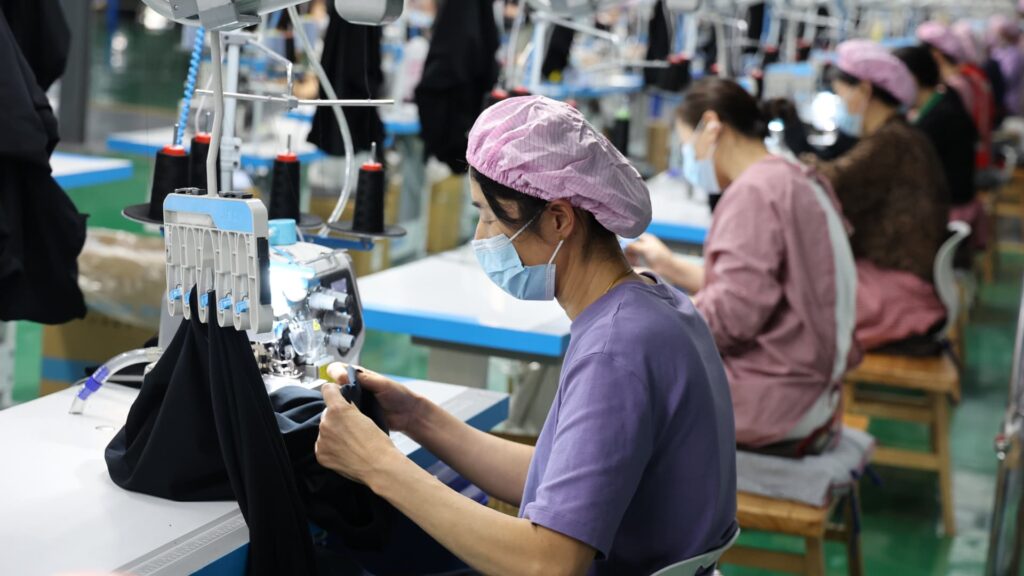Textile workers in Binzhou, Shandong, China, on April 23, 2025.
Nurphoto | Nurphoto | Getty Images
BEIJING — Chinese manufacturers are halting production and exploring new markets as U.S. tariffs take effect, according to reports from various companies and analysts.
This slowdown in orders is also affecting employment.
“I personally know of several factories that have asked half of their workforce to stay home for a few weeks and have reduced their production significantly,” stated Cameron Johnson, a senior partner at Tidalwave Solutions based in Shanghai. He noted that factories producing toys, sports equipment, and budget goods are currently facing the most challenges.
“Though the situation isn’t widespread yet, it is becoming evident in the main export centers of Yiwu and Dongguan, raising concerns that it might escalate,” Johnson explained. “There’s a hope that tariffs may eventually be reduced, allowing orders to resume; however, for now, companies are putting employees on leave and scaling back production.”
Goldman Sachs estimates suggest that 10 million to 20 million workers in China are connected to businesses that export to the U.S. The previous year, the total number of workers in urban China stood at 473.45 million.

This month, the U.S. announced tariff increases of more than 100% on Chinese goods, with China responding in kind. Although U.S. President Donald Trump indicated that trade discussions with Beijing were ongoing, Chinese officials refuted that claim.
According to Ash Monga, founder and CEO of Imex Sourcing Services in Guangzhou, the recent spike in tariffs has a “far greater” impact than the effects of the Covid-19 pandemic. He pointed out that for small enterprises with limited resources, the sudden tariff increase could be catastrophic and lead to closure.
He mentioned that there is a high demand from clients and other importers for Chinese products, prompting him to launch a “Tariff Help” website to assist small businesses in finding suppliers outside of China.
Livestreaming
The ongoing business challenges are prompting Chinese exporters to adopt innovative sales methods.
Woodswool, an athleticwear company located near Shanghai in Ningbo, swiftly moved to sell its products online in China through livestreaming. Since initiating this sales approach about a week ago, the company has secured over 30 orders, amounting to more than 5,000 yuan ($690).
This marks a small but significant step in recovering from lost business.
“All our U.S. orders have been canceled,” declared Li Yan, the factory’s manager and brand director of Woodswool, speaking in Mandarin and translated by CNBC.
Previously, over half of their production was dedicated to the U.S. market, but some capacities will remain unused for two to three months as they strive to establish new sales avenues, Li stated. Historically, they have sold to customers in Europe, Australia, and the U.S. for more than two decades.
This shift to livestreaming aligns with efforts by major Chinese tech firms, as directed by the government, to help exporters reroute their products to the domestic market.
Woodswool is selling online via Baidu, which offers a livestreaming e-commerce platform within its search engine app. Li opted for the virtual human livestreaming feature, allowing for a quick setup within two weeks without needing extensive investments in studio renovations or additional personnel.
Baidu announced its collaboration with hundreds of Chinese enterprises to establish domestic e-commerce channels and has promised subsidies and free AI tools—such as “Huiboxing” virtual humans—for up to 1 million local businesses. These virtual beings use AI to simulate sales presentations and automate customer interactions, with reports suggesting a better return on investment compared to human sales personnel.
Domestic market challenges
E-commerce platform JD.com was among the first to extend similar assistance, committing 200 billion yuan ($27.22 billion) to purchase Chinese goods originally meant for export and finding ways to sell them domestically. Food delivery service Meituan is also set to assist exporters in local distribution without providing specific funding details.
Nevertheless, this $27.22 billion commitment is merely 5% of the $524.66 billion worth of goods China exported to the U.S. last year.
“Some businesses have reported that at tariff rates of 125% or more, their business models are no longer viable,” reported Michael Hart, president of the American Chamber of Commerce in China, during a press briefing. He also pointed out a recent uptick in competition among Chinese firms.
Hart commented that tariffs from both nations are likely to persist at certain levels, with exceptions for specific tariffs. “It appears that’s the direction they’re heading towards.”
Products designed for U.S. suburban customers may not effectively appeal to Chinese apartment residents.
Manufacturers have turned to Chinese social platforms like Red Note and Douyin (the local TikTok version) to request consumer support; however, there is growing fatigue among users, warned Ashley Dudarenok, founder of ChoZan, a marketing consultancy in China.
Looking outside the U.S.
Increasingly, Chinese businesses are avoiding rerouting exports to the U.S. via other countries due to enhanced U.S. scrutiny of transshipping, Dudarenok informed. She noted that many firms are shifting their production to India instead of Southeast Asia, while some are redirecting their focus from U.S. to European and Latin American customers.
Certain companies have successfully established trade routes outside of the typical U.S. channels.
Liu Xu operates an e-commerce business, Beijing Mingyuchu, which sells bathroom products to Brazil. Despite challenges from currency fluctuations and high shipping costs, Liu believes that the trade with Brazil will ultimately remain unaffected by the ongoing U.S.-China tensions.
China’s exports to Brazil have doubled from 2018 to 2024, reflecting similar trends with exports to Ghana.
Amid the Covid-19 pandemic, Cotrie Logistics, based in Ghana, was founded to assist businesses with sourcing, manage shipments during port disruptions, and develop reliable logistics routes, according to CEO Bright Tordzroh. Their operations primarily involve trade between China and Ghana, generating annual revenues between $300,000 to $1 million.
The U.S.-China trade disputes have prompted many firms to consider sourcing and manufacturing options beyond the U.S., which Tordzroh hopes will provide further prospects for Cotrie.



